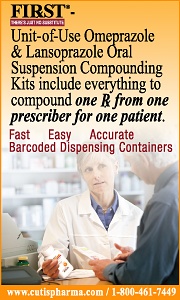|
Editorial: Current Good Manufacturing Practice (cGMP) Regulations, Part 6
This week, we will summarize Subpart D: Equipment. The following are the subpart sections and a brief description of their content.
211.63 Equipment Design, Size, and Location
The narrative in this section is common in many standards, specifically that the equipment used "shall be of appropriate design, adequate size, and suitably located to facilitate operations for its intended use and for its cleaning and maintenance."
211.65 Equipment Construction
The emphasis here is on the surfaces of the equipment that contact the components, in-process materials, or drug products. These surfaces must not be reactive, additive, or absorptive and must not alter the safety, identity, strength, quality, or purity of the drug product beyond the official or other established requirements. Also, any lubricants, coolants, or other substances required for operation must not come into contact with any part of the product to alter its established requirements.
211.67 Equipment Cleaning and Maintenance
Equipment and utensils must be appropriately cleaned and maintained for the specific drug characteristics; also, sanitized and/or sterilized at appropriate intervals to prevent malfunctions or contamination. Written procedures must be established and followed.
211.68 Automatic, Mechanical, and Electronic Equipment
Equipment must be appropriately and routinely calibrated, inspected, or checked according to a written program designed to assure proper performance; written records must be maintained. Appropriate controls must be exercised.
211.72 Filters
Filters must not release any material(s) into the drug product
Loyd V. Allen, Jr., PhD, RPh
Editor-in-Chief
International Journal of Pharmaceutical Compounding
Remington: The Science and Practice of Pharmacy
|
|
Robosurgery Injuries and Death Reports Increase
With nimble robotic instruments doing the delicate work usually performed by doctors hands-on, patients are told there will be less pain and bleeding. Robot systems made by Intuitive Surgical Inc. are linked to at least 70 deaths since 2009, according to a review by Bloomberg News. The robots cost $1.5 million each. The number of U.S. procedures done with the robots has grown to about 367,000 in 2012, compared with 292,000 in 2011, and 228,000 in 2010. Most of last year's procedures involved gynecological treatments; others involved prostate and gall bladder removals, as well as heart surgery.
Tough new questions about safety have been raised; they come as the technology is already facing criticism for raising surgical costs at a time when few large, randomized trials document significant health benefits for the robots, compared with standard less-invasive operations.
http://www.bloomberg.com/news/2013-03-05/robosurgery-suits-detail-injuries-as-death-reports-rise.html
Drug Overdose Deaths Increase for 11th Consecutive Year
Nearly 60% of the drug overdose deaths in 2010 involved pharmaceutical drugs, and opioid analgesics (oxycodone, hydrocodone, methadone) were involved in about three of every four overdose deaths. A total of 38,329 individuals died from a drug overdose in the U.S. in 2010; a steady rise in overdose deaths has occurred for the past 11 years, starting with 16,849 deaths in 1999.
Substantial deaths also occur from medications often prescribed for mental health conditions (benzodiazepines, antidepressants, antipsychotics).
A number of actions are being used to approach this problem by both federal and state agencies.
http://www.pharmacist.com/deaths-drug-overdose-increase-11th-consecutive-year
|
|
�that Daylight Savings Time (DST) begins this weekend? The idea of daylight saving was first proposed in 1895 by George Vernon Hudson, and it was first implemented during the First World War. Many countries have used it periodically since then. Although most of the U.S. used DST throughout the 1950s and 1960s, DST use expanded following the 1970's energy crisis and has generally remained in use in North America and Europe since that time. Although daylight saving time is considered to be correct, daylight savings time (with an "s") is commonly used. |



